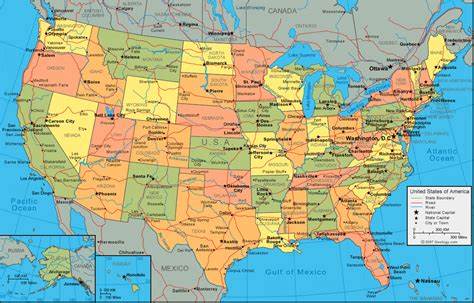A driving vacation to see the USA, is a dream for many people. The antics and craziness of the America road comedy film, National Lampoon’s Vacation will either scare off or entice a person to take a road trip to see the country. A driving vacation offers countless advantages and opportunities. It allows the individual to be in charge of where to go, select sights of interest, and how much time to spend at each location. Road trips can be short jaunts or extended treks across the USA.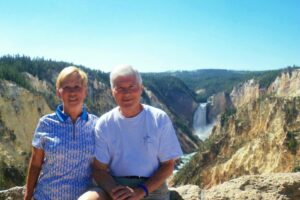 Our retirement goal is to take extended road trips to various parts of the USA. We have successfully accomplished multi-week vacations in the USA and Europe. Driving trips have been from a couple of weeks to as long as two months. A few of our roundtrip driving adventures include East Coast: Florida to Maine, the Northwest Coast: Oregon, Washington, Canada, & Alaska, and Across the USA: Florida to California. A multi-week road trip takes careful planning and flexibility. We’ve learned a lot on mapping out and setting up the details of a road trip. Below are the basics of a multi-week road trip plan. To help understand the various details of preparing a road trip, our example is our 2-month roundtrip Yellowstone National Park Road Trip from Florida to Montana.
Our retirement goal is to take extended road trips to various parts of the USA. We have successfully accomplished multi-week vacations in the USA and Europe. Driving trips have been from a couple of weeks to as long as two months. A few of our roundtrip driving adventures include East Coast: Florida to Maine, the Northwest Coast: Oregon, Washington, Canada, & Alaska, and Across the USA: Florida to California. A multi-week road trip takes careful planning and flexibility. We’ve learned a lot on mapping out and setting up the details of a road trip. Below are the basics of a multi-week road trip plan. To help understand the various details of preparing a road trip, our example is our 2-month roundtrip Yellowstone National Park Road Trip from Florida to Montana.
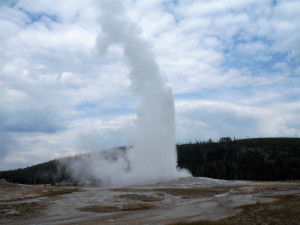
Where to go? Is there a primary destination?
Decide if there are “must see” or “bucket list” places. Pick the major ones, evaluate the time needed for the trip, and monies for making such a trip. Additionally, we check locations along the way in “1000 Place to See Before You Die” to select other destinations to include while in certain areas or states. Our primary goal is to visit Yellowstone National Park. Our secondary goal is a three-week respite from the hot Florida summer to the cool Colorado Rockies. After our first couple of road trips, we discover having a one-week to three-week rental in one location adds a reprieve on a multi-week driving trip.
How many days or weeks to be gone? How far is the primary destination? How much time for primary locations? What time of year to travel?
The length of a trip may be dictated by other factors and responsibilities requiring a return by a specific time. We generally have an idea of the time to be away but sometimes where we are going and the driving distance, become major factors in the length of time for a trip. Usually our Road Trip is at least three weeks. In the Yellowstone National Park Road Trip, we seek a three-week stay in the Colorado Rockies and a week for Grand Teton National Park and Yellowstone National Park. Immediately, this Road Trip is a month, before planning any details of the drive there and back. Time of year for a Road Trip is most important. Typically, spring, summer and fall are the better times to prevent issues with winter weather. The location and part of the country may also impact when to go. For our Northeast trip, the late spring is best as hotel rates are better and it avoids summer crowds. Our Yellowstone National Park Road Trip is August and September with a goal to be at the National Parks after Labor Day weekend. This avoids summer crowds plus better hotel rates.
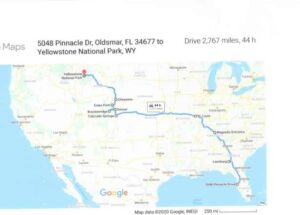
Mapping out the Road Trip! How long for travel days? Create a Road Trip Calendar
Yes, a road trip requires looking at the map. Whether using a good ol’ hard copy map, Google Maps, or GPS, it is necessary to look at places to stop along the way, driving distances, driving times and best routes. Our goal for destinations is at least 2-nights and preferably 3-nights to allow time to visit and experience the area. For driving days to destinations, the preference is 7 hours or less. For this trip, we will visit with family in Leesburg, Georgia the first few days. Looking at the map and driving options for getting to Colorado, we select Nashville, Tennessee (8-hour drive) for two nights and St. Louis, Missouri (5-hour drive) for three nights. This allows time for golf and activities at the Gaylord Opryland Hotel in Nashville and 3 days of sightseeing in St. Louis, The Gateway. As seen on the Road Trip Calendar, the next two days are driving days from St. Louis to Salinas, KS and then to Colorado Springs, Colorado at the Broadmoor. Seeking to do sightseeing in the Denver area before going to a Vacation Rental by Owner (VRBO) cabin in Breckenridge Colorado, we stay a couple of nights at the Omni Interlocken outside Denver and Doubletree by Hilton.
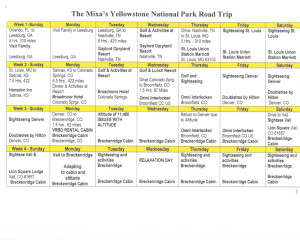 Our Road Trip Calendar starts with dates, days, driving distances, driving time, and locations. As we research and arrange accommodations, activities, etc. for the trip, these are added to the Road Trip Calendar. The Road Trip Calendar is our primary document providing all the details of our trip in one location. For this road trip, our plans are confirmed from Florida to Colorado and for the Yellowstone National Park, covering a 5-week period. Three weeks in the rental allows time to finalize the remainder of the trip both to Yellowstone and the return drive to Florida. Otherwise, reservations are being made two months out and we prefer flexibility at this time. On this trip, later planning opened up an exciting stay at Rocky Mountain National Park, a couple of great days in Cheyenne, Wyoming. Then leaving Yellowstone, we decide on treks to Devil’s Tower, Mount Rushmore and the Badlands. This allows visits with relatives in Michigan before heading back to Florida.
Our Road Trip Calendar starts with dates, days, driving distances, driving time, and locations. As we research and arrange accommodations, activities, etc. for the trip, these are added to the Road Trip Calendar. The Road Trip Calendar is our primary document providing all the details of our trip in one location. For this road trip, our plans are confirmed from Florida to Colorado and for the Yellowstone National Park, covering a 5-week period. Three weeks in the rental allows time to finalize the remainder of the trip both to Yellowstone and the return drive to Florida. Otherwise, reservations are being made two months out and we prefer flexibility at this time. On this trip, later planning opened up an exciting stay at Rocky Mountain National Park, a couple of great days in Cheyenne, Wyoming. Then leaving Yellowstone, we decide on treks to Devil’s Tower, Mount Rushmore and the Badlands. This allows visits with relatives in Michigan before heading back to Florida. Making Reservations for Accommodations. What’s the budget and estimated rate per night? Where to Stay? What is needed?
Making Reservations for Accommodations. What’s the budget and estimated rate per night? Where to Stay? What is needed?
Once we have a basic plan for the first couple of weeks of travel, we look for best accommodations to meet our needs. Points to consider are walking distance to sights, public transportation, parking fees, complimentary breakfast, type of hotel room (king), free WIFI, refrigerator, microwave, laundry facilities, and any other special things desired for a hotel. TripAdvisor is very good for locating hotels. Their reviews provide excellent guidance on positives and negatives of each accommodation. Based on accommodations, that best meet our needs, we compare prices from the TripAdvisor List directly with the hotel, AAA Membership, and other websites (Trivago, Expedia, etc.). Cancellation policies may also impact which booking service to use. In one instance the cancellation policy is better with AAA Membership or directly with the hotel. In another instance booking with AAA Membership waives the parking fee. When possible, select a hotel brand to use frequently for getting reward points, i.e. Hilton has a wide family of hotels in various price ranges. Additionally, Visitors Bureaus have excellent listings of accommodations and often have special rates on their websites. A little research can make a big difference and today’s electronic world makes it easy to do. Have an idea of what a budget for each night of accommodations. Travelers with bigger pocketbooks have the luxury of looking at more 4 & 5 star accommodations while others will focus on at least 3 -4 star accommodations. In more remote areas, hotel accommodations can get a bit challenging, so here we attempt to look at well-known hotel chains and TripAdvisor reviews.
Planning a Road Trip, has us in charge of the trip, activities, time and monies. We decide how and where monies are spent. Typically, our budget is to average $125 -$175 a night for accommodations. (Destinations of major cities will change the nightly rate significantly.) Breakfast included is very important, however, there are breakfast items that are easy to have in the room. Using a 30 day road trip as an example with $150 a night for accommodation the cost is $4,500. Compare that to a European River Cruise for 15 days for a couple is $7,798.00 (15 day cruise $3,899 per person X 2 people = $7,798.00.) Double that for a 30 day comparison, the new total is $15,596. This cruise rate does not include taxes or port charges. It does however include meals and tours.
Note: As travel journalist we often get complimentary or special rates for accommodations. These opportunities may impact the number of days, dates, and nights at specific locations. For this trip it is a combination of complimentary stays, media rates, and self-pay. Originally our trips are all out-of-pocket, so we seek good accommodations at a reasonable rates. In discussing our Yellowstone National Park Road Trip with family and friends, who have visited Yellowstone National Park, each mentions the advantages of staying in the Park (reservations have to be made many months or year in advance). We are planning a month out so this is not an option. Those staying outside the Park, explain the long driving distances each day just to get into the park and back makes it challenging to get to see all areas and not be exhausted from driving. Looking at a map of this massive Park we decide to start in Jackson, Wyoming to do the Grand Teton National Park and south area of Yellowstone National Park. Then from there we opt to spend a night on the West in West Yellowstone, Montana North in Gardiner, Wyoming, and finally exit to the East staying in Cody, Wyoming. This significantly decreases long drives from one location into and out of the Park each day just to get to the selected sights. Additionally, a cooler is a must on a trip. Often for travel days and especially in Parks, where food can be hard to find and expensive, we have items for sandwiches, etc. for easy picnic lunches.
In discussing our Yellowstone National Park Road Trip with family and friends, who have visited Yellowstone National Park, each mentions the advantages of staying in the Park (reservations have to be made many months or year in advance). We are planning a month out so this is not an option. Those staying outside the Park, explain the long driving distances each day just to get into the park and back makes it challenging to get to see all areas and not be exhausted from driving. Looking at a map of this massive Park we decide to start in Jackson, Wyoming to do the Grand Teton National Park and south area of Yellowstone National Park. Then from there we opt to spend a night on the West in West Yellowstone, Montana North in Gardiner, Wyoming, and finally exit to the East staying in Cody, Wyoming. This significantly decreases long drives from one location into and out of the Park each day just to get to the selected sights. Additionally, a cooler is a must on a trip. Often for travel days and especially in Parks, where food can be hard to find and expensive, we have items for sandwiches, etc. for easy picnic lunches.
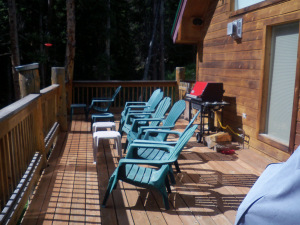
Decide if extended stay in one location is desired. Select a location for extended stay.
As mentioned earlier, we prefer having an extended stay in one location on a driving trip. This creates a nice reprieve from hotel hopping and allows time to really experience a specific area. It is relaxing to unpack and settle in to one place. A one-week to one-month rental, is excellent to fit into a road trip. Decide what best fits time, schedule, budget and preferred location. What specifically is needed: number bedrooms, baths, TV, Cable, WIFI, parking, washer/dryer, etc.? Rentals are easy to find with VRBO and Air BnB whether for a few days or for an extended time. In our instance, we select a house through VRBO in Breckenridge, Colorado for a 3-week rental. A learning experience from a prior mountain rental is paved roads to the property and steepness of the driveway. In one rental a 4-wheel drive was required. While the owner mentions the Breckenridge house is 11,400 feet elevation, the significance of this doesn’t click. On arriving, Richard is sluggish, tired, no energy and not wanting to do anything. It’s “altitude sickness!” We’ve rented the place for 3 weeks! We assumed that driving to the Rockies would provide time to acclimate to the altitude. It does not. A call to our Primary physician in Florida, gets a prescription for altitude sickness medication and a visit to Emergency Room gets prescription for oxygen to use at the rental. Additionally, as can be seen on the Calendar, we return to Denver a few days to help recuperate and also take short fun excursions to Vail and Aspen, which are at lower altitudes.
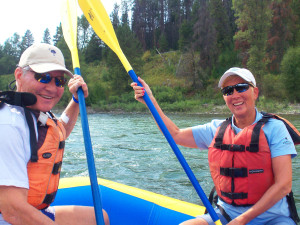
Things to do in desired destinations: Preplan or Spontaneous
As plans come together, consider the types of activities to do in the selected destinations. TripAdvisor and Visitors Bureaus are very good starting points for deciding these. Depending on the location, as well as, whether or not it is a tourist season usually influences preplanning or being spontaneous. Often the activities are finalized once we arrive so we can easily adjust them based on the weather and other activities we want to do. This allows flexibility to decide once we reach a destination. On the Yellowstone National Park Road Trip most of our activities are planned along the trip using Visitors Bureaus, TripAdvisor and local travel materials. As Travel Journalist, we often work close with Visitors Bureaus that provide Press Passes to major attractions in the cities. Yet, we also find spontaneous activities that get us unique adventures. On this Road Trip some of our last minute plans get us the Colorado Sightseer Tour in the Denver area, the fun Hummer Ride in Rocky Mountain National Park and using the Gaperguide in Grand Teton and Yellowstone National Parks.
Before you leave:
• Prepare a notebook or folder with hard copies of all travel arrangements and Your Road Trip Calendar. Electronic copies are great but many areas of the country do not have good cell service and the ability to access electronics may be limited or expensive with roaming charges.
• GPS – is necessary on road trips. Today smart phones and car GPS make this much easier. Still it is good to have a hard copy map, in case something goes wrong with GPS or there is no cell service.
• Packing – the great thing with a driving trip is you have room in the car for as much or little as you want. Since we usually golf, the golf clubs take a lot of space. Pack for various weather and realize that casual attire is good most anywhere. Have one nice outfit. Laundry can be done along the trip, as needed. Many hotels have laundry facilities.
• Car serviced –prior to starting a road trip always get the car serviced, oil changed, brakes checked and be sure to have good tires.
Now with the basics of the trip in place and outlined on the Road Trip Calendar you can prepare a road trip. Plus the Checklist for Closing the House before a trip is below to assist with several final details. Don’t just dream about it “DO IT!” See the USA! Plan a Road Trip and enjoy the many sights this great nation offers. You’ll be glad you did!
CHECKLIST FOR CLOSING HOUSE
Before leave Administrative Items
□ Two Credit cards for trip
□ Bank Debit card
□ Hold mail or forward mail
□ Key to house to neighbor or family member
□ Suspend auto insurance 2nd car
□ Email itinerary to family
Take on Trip:
□ AAA Card
□ Maps for states/cities
□ Road Trip Calendar – Itinerary
□ Book/Folder with details of trip
□ Passports (if needed)
□ Car Insurance file
□ Home Insurance file
□ Wills/Legal Paper file
□ Checkbook
□ Cell phones, iPads, Laptop/mouse, cords/chargers
□ Blood pressure machine
□ Neck pillows, pillow(s)
□ Yoga mats
□ Towels or beach towels
□ Binoculars
□ Laundry supplies
□ Cooler & ice packsPrepare House:
□ Outdoor plant pots in flower beds
□ Welcome mat & plant stands in garage
□ Lanai furniture in garage
□ Hose and garbage can in garage
□ Make sure no loose items outside
□ Disconnect battery to 2nd car (optional)
□ Empty refrigerator OR empty of perishables and have it full of containers filled with water.
Final Items day/evening leave
□ Unplug all lamps, appliances, TV, TV cables, and power cords
□ Unplug washer and dryer
□ Disconnect water hookup washer
□ Turn off water to house outside/optional
□ Turn off refrigerator & prop doors open, OR leave on- filled containers of water in it
□ Turn off water heater
□ Turn off circuit breakers on kitchen appliances
□ Turn AC to warmer/cooler temp as appropriate for season
□ Close all closet doors
□ Verify all windows are locked
□ Close all blinds, verticals and curtains
□ Verify all lights in closets/rooms are off
□ Close doors between all rooms
□ ½ cup bleach each toilet and cover with saran wrap
□ Lock door between garage and house
□ Keys to 2nd car in other location
Notes on checklist:
• Credit Cards – always have at least 2 credit cards. Verify if need to advise credit card company of travel plans or not. Most today only require if you are going out of the country. On three trips we have had a credit card cancelled, despite having contacted the credit card company with details of our travel plans. Attempting to get a new card mailed while traveling is difficult.
• 2nd Car –when away an extended time suspend auto insurance on the 2nd car. If anything should happen to it in garage, it is covered under home owners insurance. Disconnect the battery as electronics continue to run off the battery and it will be drained before you return. Also put keys to 2nd car in a location where not visible.
• USPS Mail – mail can only be held for 30 days. So if gone longer suggest forward to another individual.
• Washer & Dryer – unplug washer and dryer. Also disconnect water hookup to washer (if don’t turn off water to house). Hoses on the washer can give way and flood the house.
• Turn Off Circuit breakers to kitchen appliances (microwave, dishwasher, stove – NOT refrigerator unless it is empty). As soon as there is a power failure (often in Florida) it will just flash for PF. Plus no need to have power to these when not home.
• Toilets – pour half cup bleach in toilet. Then cover the toilet bowl area with plastic wrap (red plastic is good as it is seen). Otherwise the toilet bowl water will evaporate and pests can get in. One time we had a big frog in ours. Now with the bleach in the bowl, it is all clean and sanitized on our return.

